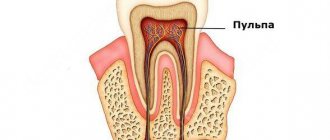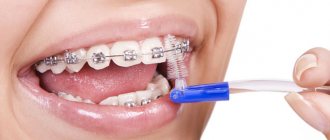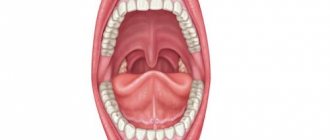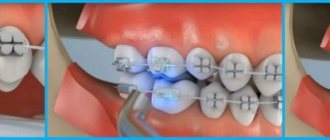Tooth nerve and need for removal
A tooth is not just a bone. In its roots there is a living pulp - blood vessels with nerve endings. This pulp is called the dental nerve; with its help, the tooth senses heat or cold. If the pulp is removed, the tooth dies, is not supplied with blood, is easily destroyed, and is less resistant to influence.
If a tooth is affected by caries, at first the destruction involves only dentin, the durable tissue of the tooth. But if caries is not treated in a timely manner, it will reach the pulp and pulpitis will begin. Then the pulp has to be removed - completely or partially, and if the pulpitis has reached periodontitis, the pulp has to be completely amputated. The nerve is also removed in case of mechanical destruction or prolonged pain.
How to calm the tooth nerve yourself
In some cases, it may not be possible to visit a dentist in the near future. For example, if you are far from the city, where it is impossible to find a specialized clinic. Then you can use traditional medicine recipes, use a soda-salt solution. To do this, you will need to dilute baking soda and salt in warm water and rinse your mouth. If soda and salt are not available, you can use 3 percent hydrogen peroxide, which is diluted with water in a ratio of 2:1. Then the swab is moistened in this solution and applied to the painful area of the dental system.
We looked at how to calm the dental nerve at home if you are unable to visit a dentist. Additionally, you can use herbal decoctions based on mint or chamomile. In some cases, clove essential oil is used. It is enough to drop it on a cotton swab and apply it to the painful area. It has good anti-inflammatory and antiseptic effects. However, if these funds are not at hand, and you do not know how to numb the tooth nerve that is inflamed, call the dentist on duty. It is better, of course, to immediately go to the doctor, since an independent decision can lead to the development of dangerous complications.
Removal with arsenic
Once upon a time there was only one way to remove it, it was terribly painful, especially since you had to visit the doctor several times. At first, the doctor drilled the tooth down to the pulp with a drill, which was extremely painful. Next, arsenic was placed in the hole and it was temporarily sealed with a filling. In a couple of days, the arsenic dealt with the nerve, and the tooth hurt so much that no medicine could help. Then I had to go to the doctor again, he opened the temporary filling, removed the nerve, and cleaned the root canals. Pulp is a tenacious substance, so this process was also extremely painful.
This technology poses a certain danger, because arsenic is a poison, and the doctor, when using it, must be especially careful, and the patient must be careful: if you are late with the second visit to the doctor and leave arsenic in the tooth, it will completely destroy it, which will end deletion. Dentists stopped using arsenic and developed new techniques for removing pulp.
The process of removing a nerve from a tooth
The process of removing a nerve from a tooth cannot be started without prior anesthesia. After administering the anesthetic using dental instruments:
- access to the pulp is opened,
- Root canals are thoroughly cleaned,
- all microorganisms are destroyed,
- mechanical and medicinal treatment is carried out.
To determine the length of the canal, the patient takes an x-ray or uses an apex locator (a special instrument that allows you to determine the length of the root canal). If necessary, the patient is given a temporary filling. In this situation, treatment will require another visit to the clinic. Then, after completing all the necessary procedures, a permanent filling is installed. The effectiveness of filling directly depends on the quality of endodontic treatment, so at the Ilatan Clinic we carry out this procedure under a microscope.
Modern pulp removal
Today, it is enough to go to the dentist once to remove the pulp. The doctor gives an anesthetic injection and calmly works with the tooth, removing the destroyed layer of dentin, extracting the pulp, treating and filling the canal. Sometimes inspection using a microscope is possible. To be on the safe side, your doctor may place a filling temporarily to make sure he has completely removed the pulp. And only if everything turns out to be in order, the final filling is installed.
Incomplete removal of the pulp is also possible, which makes sense if only the outer part of the pulp is affected by inflammation. Dead tissue is removed from the opened tooth, the outermost part of the pulp is removed, and the root remains intact. This is especially important on children's teeth, since the pulp is responsible for the formation of roots. When the pulp is not completely removed, the tooth is kept alive, and further destruction occurs more slowly.
How long can you walk with an exposed pulp, and for how long do you put arsenic in your tooth?
To reach the pulp zone you need to get close to it. This happens most often when patients come with complaints of severe pain. They are like a sharp piercing electric shock. The response time is very difficult to bear.
Patience does not respond well in this case.
Introduction of a composition into the prepared cavity of the chewing element to block the functioning of the pulp
When we come to see the dentist, pulpitis is already activated. Then you have to use a long-acting drug. The period of the necrotic process or after what time arsenic kills the nerve lasts at least two days. But it takes three days to completely kill living tissue. This is not only the optimal period for the composition to act on the tissue inside the canals, but during this period it will not have a strong toxic effect on the tissue of the mineral formation.
Why does a tooth from which the nerve has been removed hurt?
Patients often complain that the tooth from which the nerve was removed continues to hurt. This is a completely natural pain, the result of intervention in the body. In a couple of days the pain will go away. It can be observed when clenching teeth, when reacting to hot and cold. To reduce discomfort, take analgesic medications.
But if, due to improper treatment, the nerve was not completely removed, the pain and inflammation will return. It is possible that the canals were poorly treated, and there may also be an allergy to the filling material. It is necessary to go to the doctor immediately, since advanced inflammation can lead to tooth loss.
The tooth from which the nerve has been removed becomes dead, but it still remains and is not lost, so if you have a toothache, immediately go to the dentist. There is nothing to be afraid of - modern treatment is painless, and after it your diseased tooth will serve you for many years to come.
Why arsenic in dentistry
The use of arsenic is not very common now; modern treatment is carried out with arsenic-free pastes that contain an analgesic. After this paste is applied to the nerve, it should remain for several days. Throughout this period, the crown does not hurt, the nerve gradually dies, then it is also painlessly removed.
In case of severe carious destruction of the crown or in cases of pulpitis, the dentist will perform depulpation.
The dental nerve will be removed with arsenic in the following cases:
- contraindications to anesthesia, allergies to painkillers;
- characteristics of the body when existing anesthetics do not work;
- emergency dental treatment.
Arsenic cannot be used for treatment in the following cases:
- age up to 2 years;
- arsenic intolerance;
- poor access to the dental cavity;
- root disconnection;
- increased intraocular pressure;
- tooth root disease;
- systemic diseases of the genitourinary system.
Paste with or without arsenic is used only when pain relief cannot be performed. As soon as arsenic is added and a temporary filling is placed, the dental nerve begins to gradually die, causing the organ to hurt for some time, it may be painful to press on it and it reacts to temperature stimuli. After applying the arsenic paste, it should remain in the tooth for 24 to 48 hours.
If for some reason you cannot visit the dentist after the specified time to remove the nerve, complications may arise, even to the point where you will have to have the crown removed. To prevent this, you need to properly plan the treatment and do everything according to the dentist’s instructions.
What does tooth color change mean after pulp removal?
Nowadays, almost all private dental clinics adhere to international depulpation protocols, but outdated practices are still in use in budgetary medical institutions. The main reasons for tooth discoloration are improper preparation of the cavity for installation of a filling, poor quality of instrumentation of the canal and poor materials for filling. For example, when using endomethasone, the enamel turns yellow (a similar outcome is even prescribed in the instructions). If resorcinol-formalin paste was used for filling, the teeth may turn pink. Most often, this material is used in the treatment of baby teeth.
The nerves from wisdom teeth, which dentists call “problem eights,” are extremely rarely removed. Given their location and short service life, as well as the difficulty of cleaning from stone and plaque, they are easier to remove. As a rule, the figure eight is removed in case of incorrect eruption (if there is a slope towards the tongue or towards the cheek), tooth retention, carious lesions, pulpitis, changes in bite, displacement of the dentition.
After depulpation, you should adhere to the following recommendations:
- Avoid physical activity for the first 2 hours after the procedure.
- To avoid infection and injury to the tooth, do not eat food for 3 hours after pulp removal (you can drink warm water through a straw).
- For 5 days, exclude rough, solid foods from the diet.
- To avoid irritation of the oral mucosa, it is advisable not to smoke, drink alcoholic beverages, or eat spicy, cold or hot foods for at least 5 days.
- Rinse your mouth with antiseptics prescribed by your dentist for at least 1 day.
It is impossible to remove the dental nerve using folk remedies. Even if it can be destroyed, the pulp will need to be removed, and this can only be done with a special medical instrument.
When planning a visit to the dentist, remember that the longer you delay, the more difficult and expensive depulp removal will be. And do not forget that such intervention is recommended only if there are good reasons for it. Any dentist will try his best to keep the tooth “alive” if possible.
Causes of tooth pain after depulpation
Individual reaction of the body
It may appear in the first two days. Even after removal of the nerve, the tooth is still able to respond to strong pressure and thermal irritants, but not longer than 3-4 days. Poor quality of pulp extractors or inability to handle them
Instruments for pulp extraction are marked because they must correspond to the canal. Poor quality of canal cleaning
The presence of tissues damaged by caries will certainly lead to renewed pain and complications of the inflammatory process, so it is extremely important to remove them completely. Allergic reaction to filling materials
This rarely happens, especially if the doctor has determined in advance the patient’s body’s predisposition to allergies. Instrument fracture
If the instrument was damaged during the procedure and its remains lingered at the top of the root, they will cause pain. In the worst case, if there is already a filling, the tooth will need to be removed. Residual pulpitis
May affect one or more canals. The main symptom of such a secondary inflammatory process is aching pain, which then becomes acute. Relapse is possible with partial depulpation.











